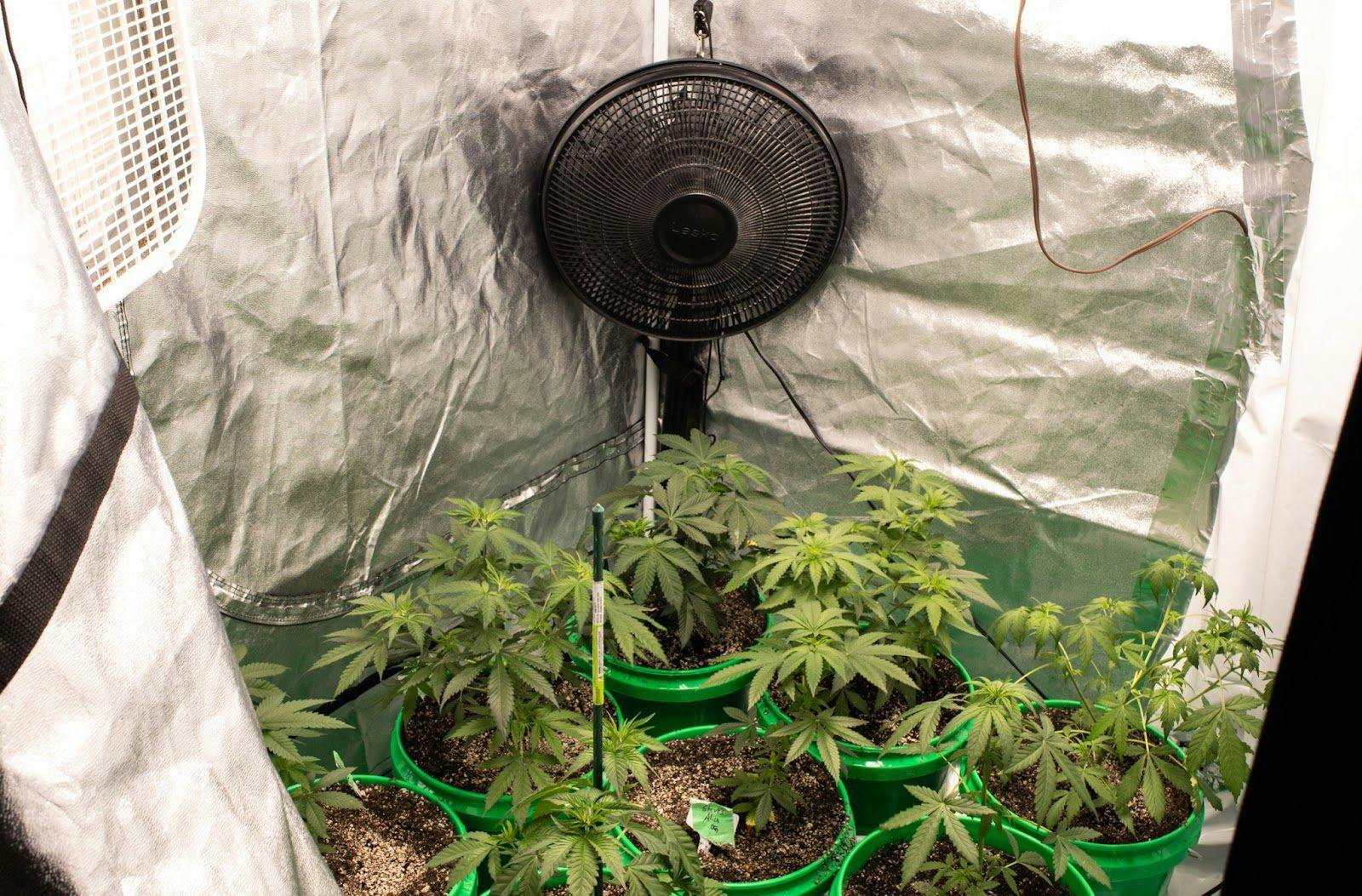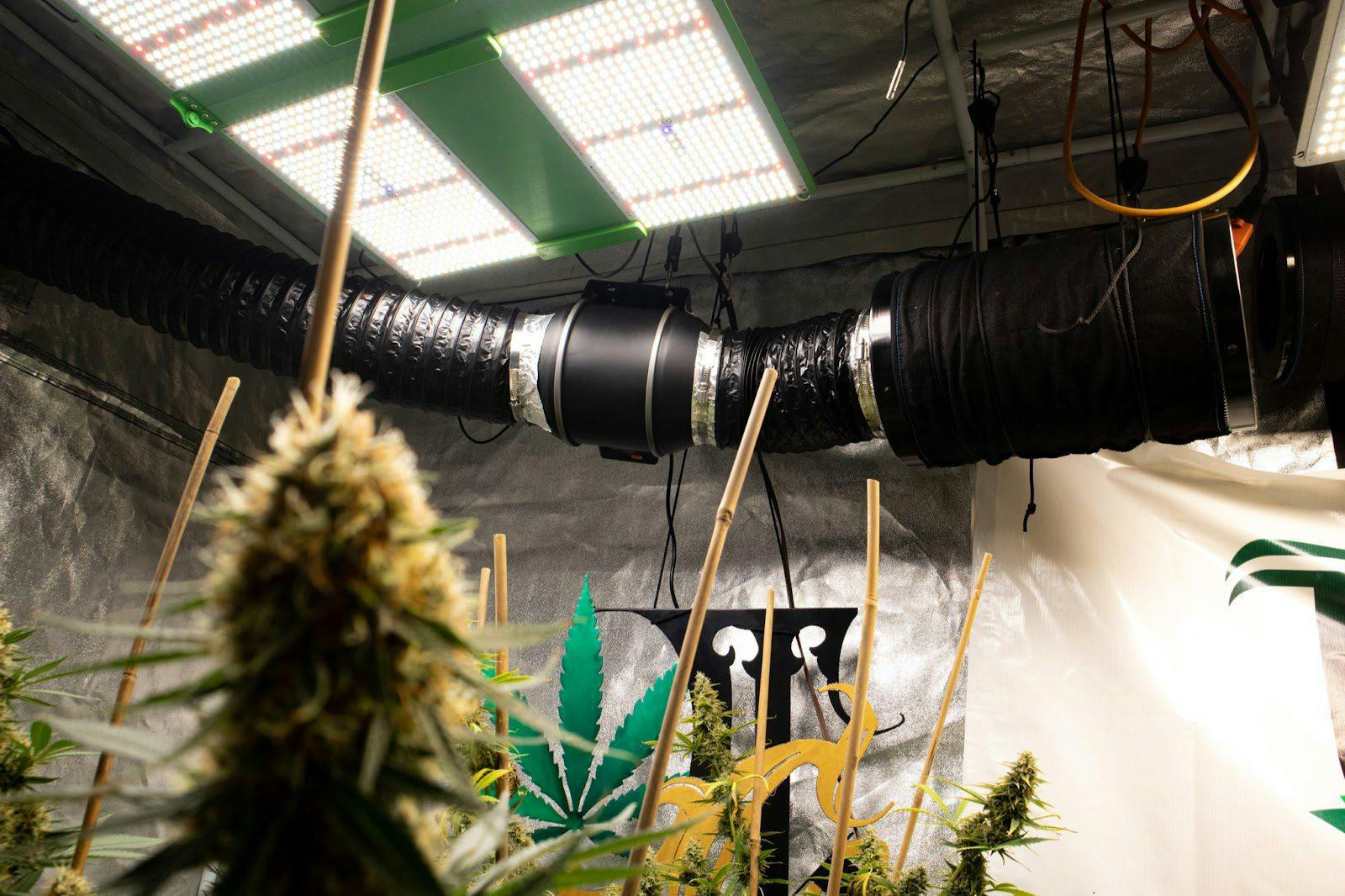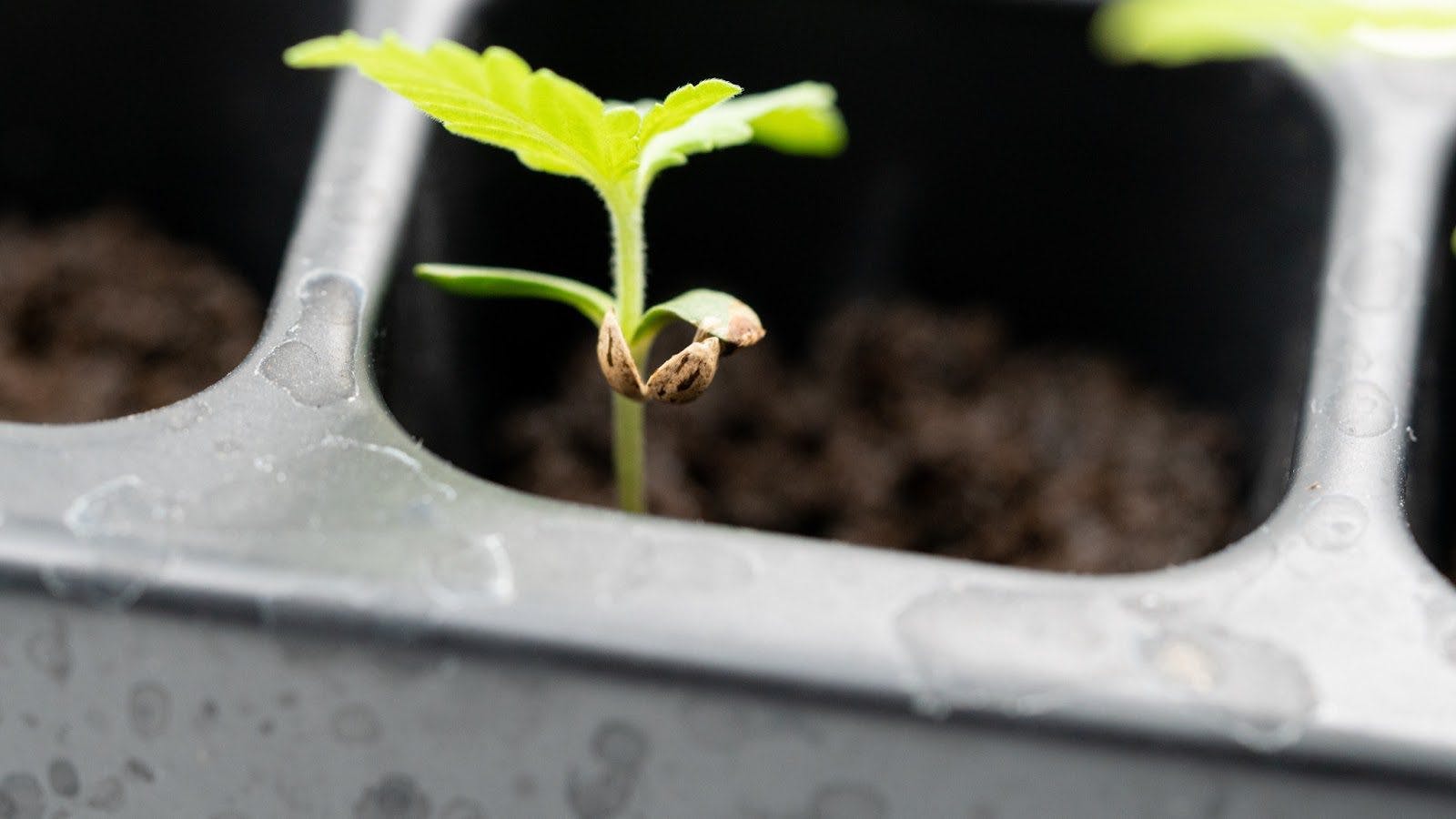Cannabis Vegetative Stage: How to Care For Your Growing Plant

Article written by

Homegrown Cannabis Co.American Seed Bank and Cultivation Experts
Content reviewed by

Dr. Lewis JasseyMedical Director - Pediatric Medicine
The cannabis vegetative stage requires plenty of sunlight, nitrogen, water, and stretching space. We also call it the growth phase because it turns a tiny seedling into a large weed plant ready to carry a mass of sticky buds.
Size equates to harvest potential: the bigger your plants get, the higher their yields. Provide appropriate TLC throughout this time, and you set the foundation for prolific flowering.
Get Your Medical Card
Connect with a licensed physician online in minutes.
What Is the Vegetative Stage?
The vegetative stage is the mid-phase of the cannabis life cycle. It happens after the seedling stage and before flowering.
During germination, seeds awaken and produce taproots. You sow them, and greenery emerges from the soil. Young plants sprout a mass of fan leaves and elongate their roots over the next 2-3 weeks.
Plants eventually become capable of photosynthesis and drawing water from the soil. They have 3-5 nodes and roots that are 2-3 inches long when vegging officially begins.
The root system expands to capture moisture and minerals. The leaves multiply as the stem ascends. There’s more space between the nodes, and side branches appear along the base.
Physical differences between indica and sativa strains appear during this time. Indica generally remains short (3-4 feet in height) and produces many bushy lateral branches. Sativa stretches taller (5-6 feet in height) and sprouts narrow leaves.
The longer this stage lasts, the larger and loftier the plant gets.
How Long Does the Vegetative Stage Last?
The vegetative stage has no set duration. It’s usually 3-16 weeks, depending on strain genetics and your gardening goals. In some cases, it might last indefinitely: for instance, cultivators may keep mother plants vegging for years and periodically take clones.
Photoperiod and autoflower seeds behave differently in vegging:
- Photoperiod plants start flowering as the days get shorter. They remain vegging as long as there are 16 daily hours of light; blooming begins when the daytime duration drops to 12 hours.
- Autoflower plants vegetate based on age and not the light schedule. They typically spend 5-6 weeks vegging and flower automatically, regardless of the length of days and nights. They perform best when they receive 18 or more hours of daily light.
If you’re working with photoperiod cannabis indoors, you can make plants flower on command by changing the light cycle. Outdoors, the switch happens in late July or early August.
Caring For Your Vegetative Cannabis Plant
Vegetative phase plants perform best in warm environments (70-85°F) with moderate relative humidity (40-65%) and strong grow lights (LED or HID). The foliage is dense and may retain moisture, so excellent airflow and regular pruning are necessary.
Once you master the basics, you can engage in training to maximize the harvest potential. Indoor growers may also experiment with their lights and supplement the space with carbon dioxide.
Let’s discuss each aspect of plant care in the cannabis vegetative stage.
Growing Medium
Cultivators raise their plants in soil, inert substrates, or hydroponics. The growing medium houses the roots, offers structural support, and helps retain moisture and nutrients. You can use:
- Soil: The most straightforward technique. Consider amending your substrate with perlite or coco coir, and introduce microorganisms to support the nutrient uptake.
- Inert substrates: Coco coir, peat moss, and Rockwool cubes. These mediums don’t contain nutrients, so you should supply fertilizer from day one.
Choose containers of appropriate sizes to accommodate rapid cannabis growth. Either start with a big pot or transplant your marijuana to a larger container as it expands.
Water
Water is essential for plant growth. It moves up the stem with transpiration, sending minerals where needed. Excessive and inadequate amounts of moisture are bad news for cannabis.
Overwatering starves the roots of oxygen and makes them rot. Underwatering leaves the plant dry and incapable of sustaining future development.
As a rule, water your marijuana plants every other day in the vegetative grow stage. Do it more frequently if they’re in small pots in scorching weather and less often if the medium is still moist. It’s a good idea to water only when the top soil inch is dry.
Check the pH of your water source after adding fertilizers to avoid nutrient toxicity, lockout, and deficiency. It should be slightly acidic (5.8-6.2).
Nutrients
Very young plants get their food from the cannabis seed, but they spend that nutrient store after 1-2 weeks. From this point on, it’s your job to feed them.
Cannabis plants in the vegetative stage require nitrogen to produce stems and leaves. Potassium regulates energy production, while magnesium and calcium support the cells and power photosynthesis.
To make feeding easier, buy the highest-quality soluble fertilizer for this growth stage. These mixes contain the ideal amounts of minerals, so follow the manufacturer’s instructions on the feeding dose and frequency.
An alternative is to put together a batch of super soil. This substrate contains organic matter and microbial life to break it into plant food. Read up on organic cultivation if you go down this route.
Download Free Guide to Plant Nutrients
Lighting

Outdoor growers should carefully choose their sowing spots. Partial shade can be helpful in scorching weather, but plants require at least six hours of daily direct sunlight exposure.
Indoor vegging plants need 18 hours of daily light and six hours of darkness indoors. You can use either of these two lamp types:
- LED: Low operational costs and heat emissions but pricey to set up. Buy full-spectrum lamps or employ blue lights for vegging and red for the flowering stage.
- HID: Low running costs and cheap to implement, but emit a lot of heat. Watch the distance between the lamp and the canopy to avoid burning your plants.
The more light your plant receives, the more rapidly it grows. For this reason, some cultivators keep their lamps active for 24 hours. However, cannabis tends to be healthier when it gets six hours of downtime.
Temperature and Humidity
Vegging cannabis plants enjoy high temperatures and moderate humidity levels. The optimal range is quite broad for both metrics, so it’s easy to keep them thriving indoors and out.
The proper humidity for the vegetative stage is 40-65%. Start at the high end of the range and reduce it by 5% each following week of the growth cycle. Use (de)humidifiers to moderate this figure indoors, and rely on the breeze and watering schedule to control it outdoors.
The ideal temperature range is 70-85°F for daylight hours and 65-75°F at nighttime. If growing weed outdoors, shade the foliage if there’s a heat wave. Indoor cultivators can use AC units and heaters to keep the temperature within range.
Airflow and Carbon Dioxide
Healthy plants require a constant source of fresh air. Ventilation introduces new carbon dioxide (CO2) for photosynthesis, eliminates excess oxygen, and can help prevent mold formation.
Use intake and extractor fans in grow rooms and tents to keep the air fresh. Outdoor and greenhouse growers should set up their gardens in the wind direction.
Adding extra carbon dioxide to your grow space kickstarts vegetative growth. Plants need more heat, water, and light to take advantage of the supplement, so read up on the technique before giving it a shot.
Pruning, Trimming, and Topping
Plants in the vegetative state are amenable to pruning, trimming, and topping and swiftly recover from physical stress.
Outdoor cultivators and newbies should stick to weekly pruning. Use scissors to remove yellow and large leaves shading the lower sections. Leave at least one pair on each branch.
Experienced growers top their cannabis to control its height and promote bushiness. Cut the top of the main stem and cause it to diverge into two branches and become bushier. You can repeat this multiple times to produce more bud sites, but give it several days between sessions.
Wait till the cannabis seedling has 3-5 nodes and sets of true leaves before topping and pruning. Use sterilized tools and be mindful of the environment while plants recover from stress.
Low-Stress Training
Low-stress training lets you coax your cannabis into a more desirable shape. This technique makes plants more compact and higher-yielding while boosting airflow and light penetration.
Instead of cutting or snapping branches, you bend and tie them down to make the canopy even and smooth. For instance, the Screen of Green technique is perfect for managing tall and slim sativa.
Expert tip: Don’t train plants from non-photoperiod seeds. Autos’ growing cycle is swift, and they don’t have enough time to recover from stress.
Most Common Problems
Marijuana is at its strongest during the vegetative growth stage. It now has robust roots and dense foliage capable of sustaining itself through the external environment.
With that said, health issues may still occur in the veg stage. Fortunately, plants tend to bounce back with minimal long-term damage. They’re even more robust when grown from the highest-quality seeds, like the ones available at Homegrown Cannabis Co.
Let’s see what symptoms you might encounter and how to address them.
Leaf Discoloration
The vegetative growth phase requires high levels of nitrogen. If the leaves go pale or yellow, they’re likely suffering from a nutrient deficiency.
Check the pH before supplying additional fertilizer. Alkaline environments can prevent the roots from absorbing minerals even if there are plenty available. Correct the imbalance and only then provide more plant food.
Check your watering schedule if the foliage is yellow, dry, and crunchy. These symptoms often happen in arid environments.
Leaf Drooping
Drooping leaves that curl under often occur due to overwatering. Hold off until the top soil inch feels dry before showering your marijuana again. Reduce the relative humidity and increase the ventilation while it dries to reduce mold risk.
Expert tip: Wilting looks similar to drooping but points to the opposite issue: underwatering. While droopy leaves are thick and green, wilting ones are thin and yellow.
Dying Foliage
Healthy plants lose a few leaves weekly, but heaps falling off are a problem. Nutrient issues, physical stress, overheating, and inadequate humidity can cause this symptom. Analyze every aspect of your environment to save your dying cannabis.
Rotten Scents
Plants still don’t have sweet-smelling trichomes in the cannabis vegetative stage. They’re mostly odor-free, smelling slightly like wood and grass. Check for mold if there’s an offensive scent in your grow area.
Remove the affected leaves and lower the humidity. You may also treat the canopy with neem oil.
Slow Growth
Low-quality cannabis seeds produce plants with slow growth rates. Even with the best genetics, you might still see stunted development due to a lack of light, nutrients, and excessive cold. In all three cases, new growth appears smaller and weaker.
Push your lamps closer to the canopy and invest in a thermometer. Measure the pH of your medium and supply quality fertilizer.
Excess Stretching
Marijuana plants grow very tall and thin, with a lot of space between the leaves when trying to reach the sun. This symptom occurs in low-light environments due to weak or faraway lamps.
Check the manufacturer’s instructions on the distance and place your lamps accordingly. Besides adjusting their position, you might increase the light intensity by adding supplemental lamps.
Pest Activity
Crawly creatures can wreak havoc on marijuana. Consider implementing an integrated pest management (IPM) system to protect plants before they become an issue.
Sow companion plants to prevent pests. These strong-smelling and brightly-colored herbs and flowers repel insects or draw their attention away from weed. Physical barriers are another great solution.
If pests attack your weed, remove them with non-chemical methods to avoid contaminating the buds. Eliminate the damaged foliage once you clear the infestation.
Undesired Plant Sex

Plants display the first signs of sex early in their life cycle: pre-flowers may appear 4-6 weeks after germination. This information lets you nip pollination risk in the bud.
Take a magnifying glass and inspect the internodes. Males contain small pieces of round tissue that later turn into pollen sacs. Female plants have thin white hairs poking from an oval organ.
Keep males in another room or discard them altogether; these plants don’t produce sticky buds.
Early Blooming
Light leaks stress flowering plants; they might halt flowering, slow it down, or turn your fems hermaphrodite. The opposite is also true: a lack of sunlight can trigger the flowering stage before you’re ready.
Pay extra attention to the light schedule or automate it to prevent errors.
How to Tell Your Plant Is Ready to Flower
Indoors, the duration of the vegetative period is a matter of personal preference. You can switch to flowering as soon as the seedling has 3-5 nodes or let plants grow for months before flipping the lights. In either case, only make the transition when your cannabis is:
- Healthy: A drastic shift in the light schedule stresses the plant. Wait till it’s in good shape to start introducing changes.
- Well-pruned: Plants don’t take well to trimming scissors in flowering. Remove excess leaves before triggering this stage to maximize light penetration.
- Around three-quarters of its desired size: Plants go through a considerable growth spurt at the beginning of flowering. Account for that while planning your space.
Flowering plants enjoy low humidity, so start reducing the moisture levels while preparing to flip the lights. Do so gradually, reducing the “daytime” by an hour each day to minimize the stress.
Growers who use low-stress training shorten vegging to several weeks. These methods require compact plants with short branches, so excessive growth isn’t desirable.
Get Your Medical Card
Connect with a licensed physician online in minutes.
Frequently Asked Questions
Does longer veg time increase yield?
Bud sites develop at the internode between the stem and branch. Larger marijuana plants have more internodes, which means more abundant harvests.
Seedlings may flower as early as 3-4 weeks after germination, but you get small plants that can’t support plenty of buds. On average, indoor growers get the highest yields if they maintain vegging for 4-6 weeks.
Do you determine the sex of the plant in the veg stage?
Weed displays its sex around six weeks after germination by producing pre-flowers: tissue that differentiates male and female marijuana.
Take a jeweler’s loupe and examine the nodes. Male plants have spherical pre-flowers, while females carry teardrop-shaped blossoms. Males are often taller and less bushy than females.
How can I increase my vegetative growth?
Cannabis plants exhibit the fastest growth rates in steady conditions with plenty of sunlight exposure or powerful lamps. High doses of nitrogen-rich fertilizer supercharge development.
Experienced cultivators might also top and train their plants. These techniques encourage weed to stretch laterally, developing a flat and bushy shape with more space for future bud sites.
